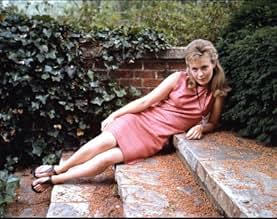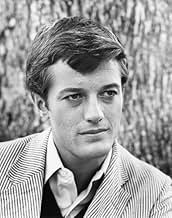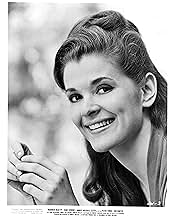IMDb RATING
6.8/10
3.4K
YOUR RATING
A war veteran gets work at a mental institution, where he meets the beautiful and eccentric Lilith.A war veteran gets work at a mental institution, where he meets the beautiful and eccentric Lilith.A war veteran gets work at a mental institution, where he meets the beautiful and eccentric Lilith.
- Awards
- 2 nominations
Walter Arnold
- Lonely Girl's Father
- (uncredited)
Rene Auberjonois
- Howie
- (uncredited)
Elizabeth Bader
- Girl at Bar
- (uncredited)
Ruth Baker
- Patient
- (uncredited)
Janet Banzet
- Patient
- (uncredited)
Amelie Barleon
- Patient
- (uncredited)
Carson Barnes
- Child Crossing Street
- (uncredited)
Jeanne Barr
- Miss Glassman
- (uncredited)
David Barry
- Ambulance Attendant
- (uncredited)
- Director
- Writers
- All cast & crew
- Production, box office & more at IMDbPro
Storyline
Did you know
- TriviaAccording to Kim Hunter: "The tensions on the set contributed to his [Rossen's] death. I don't think I want to talk about it. Since then, Warren has grown so; at that time, he wasn't ready to be a star. He knew it and was scared! In rehearsal, he'd be great. The closer he got to the camera, the more he'd retreat. He'd cut half his lines, which made Warren interesting and the rest of us talky as hell! He gave Jean no help whatsoever. She was damn good in a demanding role. At the wrap party, a group of people threw Warren into a stream".
- GoofsWhen the staff and patients are loading up to go on their picnic, two of the cars are 1955 Cadillac Fleetwood 75's. When they arrive at their destination, the cars have changed into 1958 and 1959 Cadillac Fleetwood 75's. The station wagon has changed from a 1959 Ford Country Squire to a 1960 Ford Country Squire.
- Quotes
Lilith Arthur: If you should discover that your god loved others as much as he loved you, would you hate him for it?
- ConnectionsFeatured in From the Journals of Jean Seberg (1995)
Featured review
Robert Rossen would only direct ten films in the space of 17 years and, despite their sometimes erratic quality, he was a talented and highly respected figure. His neglected and misunderstood swan-song was deemed by some a means of reparation for his former Communist beliefs and the fact that he was a friendly witness during the HUAC hearings (the confused hero wanting to make good but ending up disillusioned); when the picture was mauled by critics, he got cold feet and bailed out of his intention to present it at the Venice Film Festival!
Few American movies up to this point had revolved around insane asylums, most notably the prestigious THE SNAKE PIT (1948), Vincente Minnelli's glossy, all-star melodrama THE COBWEB (1955) and the somewhat hysterical SHOCK CORRIDOR (1963) from maverick film-maker Samuel Fuller. Still, this is more of a character study than a serious treatment of its subject matter (which, outside of the inmates played by Jean Seberg and Peter Fonda – a nice early dramatic showcase for the latter – are restricted to a handful of intense irrational outbursts, for lack of a better phrase). Even so, Warren Beatty’s brooding occupational therapist protagonist is himself often impenetrable (despite the sympathetic guidance of asylum head Kim Hunter) – justifying his own breakdown at the film’s abrupt, haunting conclusion. The essential gloominess of the piece is, however, offset by passages of lyricism (the ethereal yet experimental black-and-white cinematography by veteran Eugen Schuftan – who had won as Oscar for Rossen’s previous film, THE HUSTLER [1961] – is exquisite throughout): that said, sequences such as the lengthy interlude at the fair (complete with an archaic jousting tournament) seem to be making some obscure point or other which renders it a slightly pretentious whole.
Apart from the fact that therapist and patient are involved in a tempestuous love affair, the film’s controversial aspects entail scenes subtly depicting paedophelia, a lesbian relationship and also the temptation for an extra-marital fling by Beatty’s former girlfriend (Jessica Walter); a young Gene Hackman appears as Walter’s workaholic but uncouth husband in one scene – naturally, he would re-unite with Beatty for Arthur Penn’s seminal BONNIE AND CLYDE (1967). Despite his classic good looks, Beatty didn’t conform to Hollywood standards – opting from the outset for gritty and often demanding fare (including John Frankenheimer’s ALL FALL DOWN [1962] and Penn’s MICKEY ONE [1965]) whenever he could. The beguiling Seberg exudes effortless sensuality in the role of the enigmatic Lilith which, reportedly, was her own personal favorite; chillingly, the climactic regression into total madness of her character parallels that of the actress herself who would eventually take her own life 15 years later!
Few American movies up to this point had revolved around insane asylums, most notably the prestigious THE SNAKE PIT (1948), Vincente Minnelli's glossy, all-star melodrama THE COBWEB (1955) and the somewhat hysterical SHOCK CORRIDOR (1963) from maverick film-maker Samuel Fuller. Still, this is more of a character study than a serious treatment of its subject matter (which, outside of the inmates played by Jean Seberg and Peter Fonda – a nice early dramatic showcase for the latter – are restricted to a handful of intense irrational outbursts, for lack of a better phrase). Even so, Warren Beatty’s brooding occupational therapist protagonist is himself often impenetrable (despite the sympathetic guidance of asylum head Kim Hunter) – justifying his own breakdown at the film’s abrupt, haunting conclusion. The essential gloominess of the piece is, however, offset by passages of lyricism (the ethereal yet experimental black-and-white cinematography by veteran Eugen Schuftan – who had won as Oscar for Rossen’s previous film, THE HUSTLER [1961] – is exquisite throughout): that said, sequences such as the lengthy interlude at the fair (complete with an archaic jousting tournament) seem to be making some obscure point or other which renders it a slightly pretentious whole.
Apart from the fact that therapist and patient are involved in a tempestuous love affair, the film’s controversial aspects entail scenes subtly depicting paedophelia, a lesbian relationship and also the temptation for an extra-marital fling by Beatty’s former girlfriend (Jessica Walter); a young Gene Hackman appears as Walter’s workaholic but uncouth husband in one scene – naturally, he would re-unite with Beatty for Arthur Penn’s seminal BONNIE AND CLYDE (1967). Despite his classic good looks, Beatty didn’t conform to Hollywood standards – opting from the outset for gritty and often demanding fare (including John Frankenheimer’s ALL FALL DOWN [1962] and Penn’s MICKEY ONE [1965]) whenever he could. The beguiling Seberg exudes effortless sensuality in the role of the enigmatic Lilith which, reportedly, was her own personal favorite; chillingly, the climactic regression into total madness of her character parallels that of the actress herself who would eventually take her own life 15 years later!
- Bunuel1976
- Sep 15, 2008
- Permalink
- How long is Lilith?Powered by Alexa
Details
- Release date
- Country of origin
- Language
- Also known as
- Robert Rossen's Lilith
- Filming locations
- Great Falls, Virginia, USA(picnic scenes)
- Production companies
- See more company credits at IMDbPro
Box office
- Gross worldwide
- $542
- Runtime1 hour 54 minutes
- Color
- Aspect ratio
- 1.85 : 1
Contribute to this page
Suggest an edit or add missing content




































